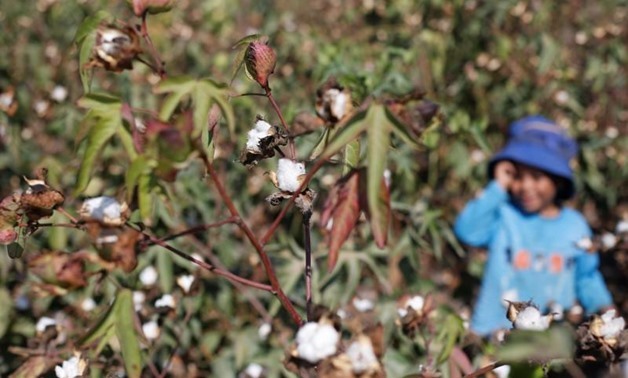
Cotton grows in a field of San El Hagar village in the province of Al-Sharkia northeast of Cairo, Egypt October 18, 2016 - REUTERS/Amr Abdallah Dalsh
CAIRO – 4 August 2018: Minister of Public Business Sector Hisham Tawfik discussed with Agriculture Minister Ezz El-Din Abou Steit on Thursday means to boost the spinning and weaving industry in Egypt and promote the cultivation of short stable cotton.
Abou Steit asserted that cotton crops have a strategic importance and that Egyptian cotton should be restored to its global position. He pointed out that the ministry worked to support the cultivation of short staple cotton instead of importing this kind of cotton by local companies.
The Ministry of Agriculture and Land Reclamation issued a report showing that the total area of cotton cultivation this season increased by 118,000 feddans (122,484 acres) on a year-on-year basis, recording about 334,621 feddans.
Head of Agriculture Services and Follow up Sector Abbas el-Shenawy told Egypt Today that the government arranged intensive campaigns aiming to control pests in cotton crops, especially after increasing the areas of cultivation to solve framers' problems in all governorates of the republic.
Kafr el-Sheikh tops Egyptian governorates cultivating cotton
The report revealed that Kafr el-Sheikh governorate came at the top of the governorates in terms of cultivating cotton with a land of 97,000 feddans, followed by Beheira by 56,657 feddans, Dakhalia by 51,352 and Sharqiah by 48,349 feddans.
Al-Fayoum cultivated 16,162 feddans of cotton, and Gharbia cultivated 14,237 feddans, according to the report.
Minister of Agriculture and Land Reclamation Abdel Moneim el-Banna said that cultivation of Egyptian cotton started to recover, referring that the minimum cultivated area reached 130,000 feddans in 2016’s season.
In 2016, the Ministry of Agriculture announced it has taken measures to support the domestic cotton sector and increase long-term productivity of the long-staple and medium-length cotton.
The exports of the Egyptian cotton amounted to $462 million in 2016, a report by ITC Trade showed.
Three new varieties of high-yield cotton crop have been registered to suit the local yarn industry and increase its yield by 10 quintals per feddan, Banna added.
According to Banna, a classification map for Egyptian cotton was also prepared and distributed in the governorates, showing the cultivated varieties in each governorate, their productivity, and a map of the cultivars and the approved varieties for each fork.
Cotton exports up 181.6 percent during Q2 of 2017-2018
Former Trade and Industry Minister Tarek Kabil said in May that the government in Egypt is keen on upgrading the system of cotton cultivation and textile industry to better meet demands of the local market and enhance exports.
The Central Agency for Public Mobilization and Statistics (CAPMAS) said that Egyptian cotton exports (from December 2017 to February 2018) increased by 181.6 percent to reach 379,700 tons compared to 134,800 tons during the same quarter of the previous year.
In its quarterly newsletter for the second quarter of the 2017-2018 agricultural year (lasting from December 2017 to February 2018), the agency said that total consumption rates of domestic cotton reached 47,200 metric kantars (one kantar is equal to 45.02 kilograms), compared to 127,600 metric kantars during the same period of the previous year, registering a decrease of 63 percent.
Once the biggest producer of cotton globally, Egypt’s more than 20 million acres of cotton crops gradually started to disappear over the years. Only 220,000 acres of long-staple cotton were grown in 2017, according to official figures.
The number, however, is still an increase from 2011 figures; for instance, 2016/17 saw only 130,000 acres of cotton, the lowest in 100 years. The Ministry of Agriculture expects to double its production in the fiscal year ending this July, whereby it would reach 1.4 million kantar (around 247,000 tons), up from 700,000 kantar in the last fiscal year, and would sell at LE 3,000 per kantar. Policies are currently being formulated to ensure the sector bounces back to its full potential.


Comments
Leave a Comment